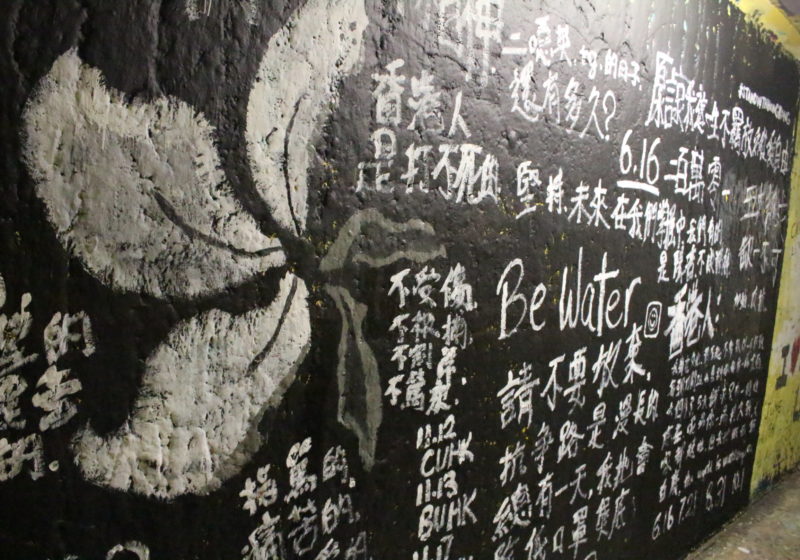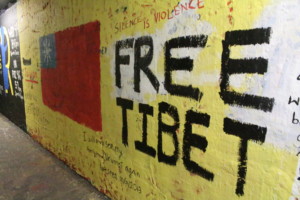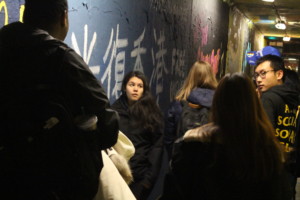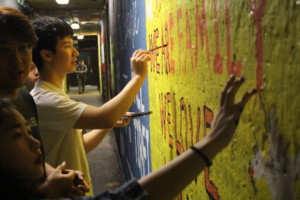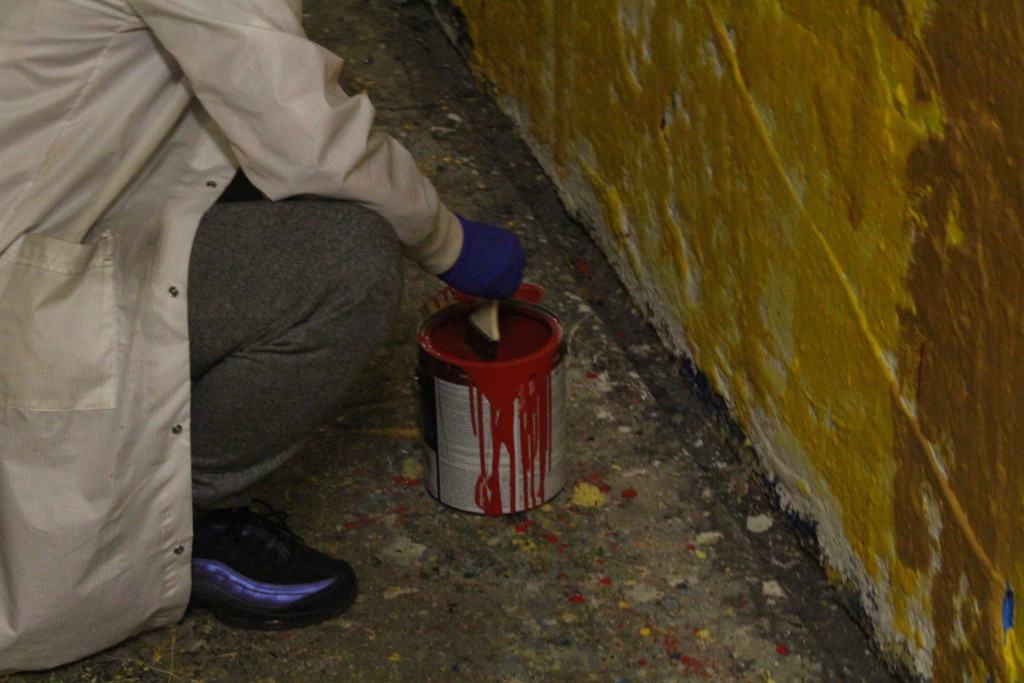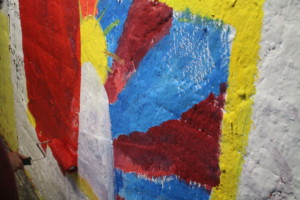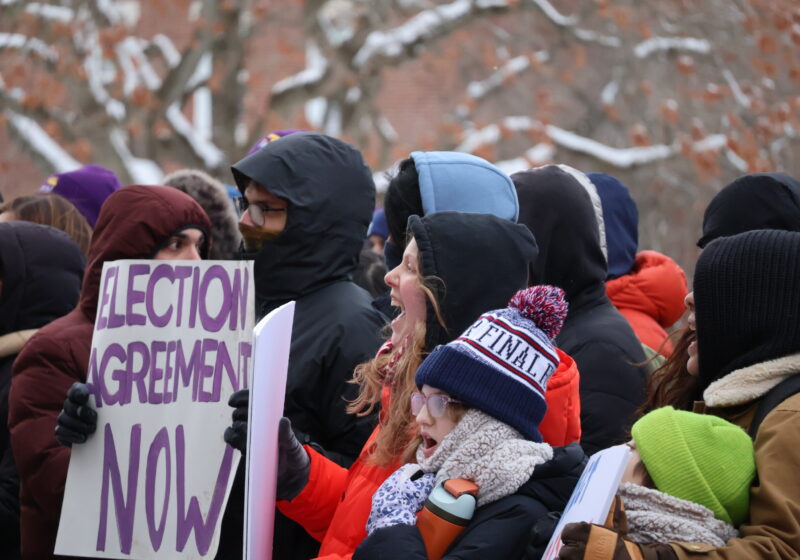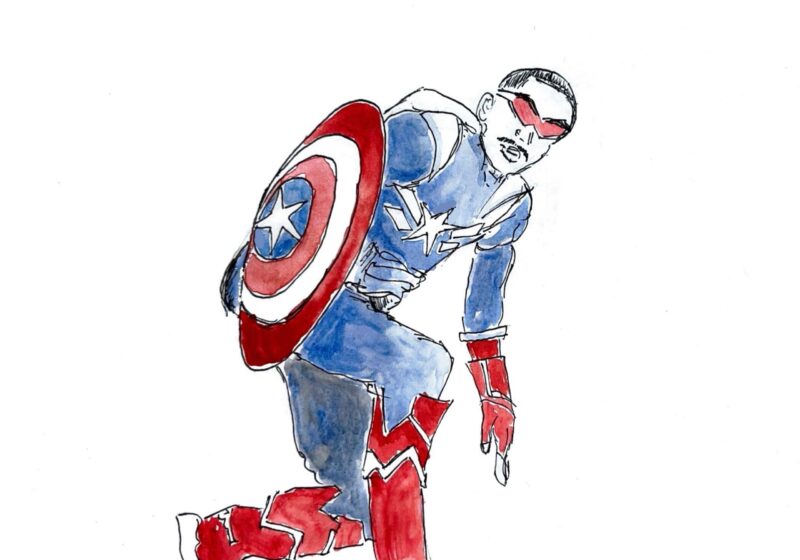As a photojournalist covering the Hong Kong protests, UR exchange student Tsz Wing Li got used to the sting of tear gas, which he compared to “fire burning on your skin.” But he’s experienced a different type of pain since leaving home and seeing the Hong Kong conflict deteriorate beyond what he had even thought possible.
“All the students here are doing their academics and continuing with their life and joy and entertainment as usual,” Li said, “while your hometown is literally on fire.”
But a group of unknown students ignited a campus-wide conversation about the Hong Kong crisis on the morning of Thursday Nov. 21 by giving the painted tunnel some fresh coats.
Emblazoned across large sections of the tunnel, messages and symbols hailed Hong Kong’s pro-democracy movement, asserted the autonomy of Tibet and Taiwan, and called for an end to human rights violations against Uighurs.
The date of the Tiananmen Square killings made several appearances. Paintings of the Taiwanese flag, and phrases like “Stand with [Uighur] Muslims,” “Free Hong Kong,” and “I ❤️Dalai Lama” dotted the hall.
Passersby often stopped in front of the large black chunk of wall that addressed the Hong Kong crisis. The writing, a mix of traditional Chinese and colloquial Cantonese, told Hong Kongers to “keep going,” and wrote messages of thanks to the protestors, reporters, and first responders on the scene.
The paintings appear after a series of campus conflicts over opposing perceptions of the Chinese government, and as protestors — many of whom are University students — remain embroiled in combat with the police in Hong Kong.
Junior Warish Orko, who said he helped paint the tunnels, said he was driven in part by seeing videos of violence against Hong Kong protestors.
The five-month-long protests began in opposition to a bill to allow Hong Kongers accused of crimes to be moved to China, but have expanded to include demands for an investigation of city police and more democratic rights. In recent weeks, the battle has encroached university campuses — Li’s university ended its fall semester early on account of the disruption.
Orko said the paintings were necessary after what he perceived to be a poor attempt from SA and school administration to support students who felt unsafe after the Starbucks confrontation between Tibetan monks and some Chinese students.
“It shouldn’t be that this campus is silent when these people are suffering,” he said.
Orko also referenced attempts to derail College Republicans’ events on Tibet and Uighurs, and the hurt expressed by some Taiwanese students after their flag in Hirst Lounge was moved to a category for “subnational entities” because Taiwan is not recognized by the UN.
At a time when both protestors and the police force have increasingly employed violence in Hong Kong, Thursday’s paintings proved particularly polarizing.
“I’m really glad these are here,” said sophomore Amber Hu, who is from Taiwan. “It says ‘I am with you; I will fight with you, please don’t give up.’”
The Hong Kong Students’ Association e-board released a statement denying any knowledge or involvement in the original paintings, but expressing approval of the show of solidarity.
Students who objected to the paintings pointed to the violence attributed to Hong Kong protesters.
“Why on Earth would you kill an old person who has different views from you,” said senior Yuxia Zhou later, referencing a much-publicized incident where a man was killed by a blow to the head.
Chinese Students’ Association president and junior Sampson Hao took his response to the tunnels.
“Personally I feel like there’s nothing wrong with what they said, however, why did they use [Chinese] instead of English?” Hao asked. “The motive is very very questionable. The people they’re trying to target is very very questionable.”
He said he hoped the statement would serve as an invitation for non-Chinese students to talk to Chinese students, instead of “assuming and mislabeling and stereotyping.”
CSA’s painting read: “We are peace/ We are family/ We love you all.” The wall they painted over had listed names of countries including Kurdistan, Yemen, and Kashmir in black.
The atmosphere seemed different two hours later at 10 p.m., for the tens of students who gathered, in response to a call from the Chinese Students and Scholars Association, in the same spot. Members of the organization — which is officially a graduate student group also open to undergraduates — did not respond to interview requests.
After a discussion, a student in a white lab coat poured red paint into a plastic container, moved it in front of a painting of the East Turkestan flag, and started painting over the symbol.
Soon, students were painting over all of the symbols and rhetoric they deemed objectionable. There were ambiguities: After a Taiwanese flag was partially painted over, students backtracked and started restoring it. A tiger was drawn through paintings commemorating the Tiananmen Square protest. “I ❤️Pandas” was sprawled on the large black mural dedicated to Hong Kongers. Over the East Turkestan flag, students painted a red square with the words “Smile” and “Meliora” plastered on top.
The tone seemed to get lighter as the night went on. The words “Happy Birthday Sis Xiao,” replaced “I ❤️Dalai Lama.” A student snapped pictures of a painter grinning, dabbing, and flashing a thumbs up in front of it. (The replacing words were later painted over.) At one point, a student stood in the center of the tunnel, operatically belting “I Love You, China” a song from the 1980s film “Overseas Patriots.” Students filmed and cheered.
Someone else also filmed, with different intent. “I got video,” junior Mustapha Ibrahim said as he stood amid the painters. “Time to make memes.”
When Ibrahim’s video landed on the Overheard at Rochester Facebook page, the outrage was swift.
“I’m seriously at a loss for words,” wrote sophomore Anna Gardner. “This is infuriating and upsetting to see supportive messages speaking up for people being painted over.”
Two anonymous posts on the popular UR Secrets & Confessions Facebook page thanked the original painters for showing compassion and giving a voice to people who could not speak for fear of government retaliation.
College Republicans president senior Anthony Pericolo released a statement Friday characterizing the new layer of paintings as part of a broader attempt to suppress free political speech, dating back to opposition to the group’s Tibet event.
Some argued that the original paintings had felt like an attack on mainland Chinese students. “I feel very strange when the entire tunnel is full of paintings about four different regions of China,” sophomore Junjie Niu wrote.
Li said he was unsurprised that the original paintings were quickly covered up, comparing it to Hong Kong’s Lennon walls: Post-it note collages that have sprung up in various parts of the city since the 2019 protests began, expressing support for the movement. Though the walls are sometimes defaced by government supporters, they are repeatedly restored again — often bigger than before.
This has already begun for UR’s painted tunnel.
On the evening of Sunday Nov. 24, students populated it once more with sentiments of liberty for oppressed groups, calling for freedom for Kashmir, Aksai, Uighurs, Hong Kong, and more. A piece demanding professor T. Florian Jaeger’s dismissal also went up. Public Safety officers were also present.
Ibrahim, who painted that evening, said he and his friends wanted to give voice to people who couldn’t speak out about their oppression. “We will continue to do that,” he said. “I’m gonna be coming back here every night if that’s what it’s gonna have to take for those messages to be up here.”
Editor-in-Chief Wil Aiken contributed reporting.
Correction (11/25/19): An earlier version of this article used an incorrect version of Jaeger’s name. His name is T. Florian Jaeger, not Florian T. Jaeger.
Correction (11/26/19): An earlier version of this article incorrectly said the Hong Kong mural was written in Mandarin and Chinese. It was actually written in traditional Chinese and colloquial Cantonese.
